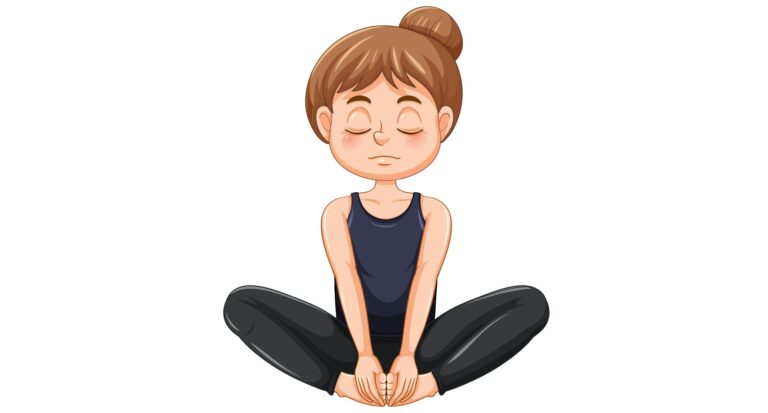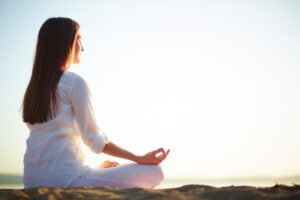Are you looking to enhance your flexibility and find inner peace? Look no further than the bound angle pose. This yoga posture, also known as Baddha Konasana / Butterfly Pose, offers a multitude of benefits for both the body and mind. In this guide, we will explore the numerous advantages of this pose, from its ability to open up the hips and increase flexibility to its potential to calm the mind and reduce stress. Discover how this simple yet powerful pose can transform your physical and mental well-being, and unlock a new level of tranquility and balance in your life. So, roll out your mat, find a comfortable seat, and let’s delve into the bound angle pose and all it has to offer.

Step-by-step Guide to Practicing Bound Angle Pose Correctly
To experience the full benefits of bound angle pose, it’s important to practice it correctly. Here’s a step-by-step guide to help you achieve the perfect posture:
Step 1. Start by sitting on your yoga mat with your legs extended in front of you. Take a few moments to ground yourself and connect with your breath.
Step 2. Bend your knees and bring the soles of your feet together, allowing your knees to fall open to the sides. Keep your spine straight and lengthened.
Step 3. Gently hold onto your ankles or feet with your hands, ensuring that your heels are close to your pelvis.
Step 4. Take a deep inhale, and as you exhale, gently press your elbows against your inner thighs, encouraging them to open further.
Step 5. Maintain this position for 5-10 breaths, focusing on deep, slow breaths and allowing your body to relax into the pose.
Step 6. If you feel comfortable, you can deepen the stretch by gently using your hands to press your knees closer to the floor.
Step 7. To release the pose, gently release your hands from your feet, extend your legs, and shake them out to release any tension.
Remember, it’s essential to listen to your body and modify the pose according to your level of flexibility. Be patient with yourself and avoid forcing your body into uncomfortable positions. With regular practice, you will gradually deepen your range of motion and experience the full benefits of Baddha Konasana.
Benefits of Bound Angle Pose / Baddha Konasana
Bound angle pose offers a range of physical benefits that can enhance your overall well-being. Here are some of the key advantages:
1. Opens up the hips: Bound angle pose is known for its ability to open up the hips, which can be particularly beneficial for individuals who spend long hours sitting or have tight hip muscles. By bringing the knees out to the sides and gently pressing them towards the ground, this pose helps to release tension and increase flexibility in the hip joints.
2. Stretches the inner thighs and groins: As you bring the soles of your feet together and allow your knees to fall open, you’ll feel a deep stretch in your inner thighs and groins. This can help to alleviate tightness in these areas and improve overall flexibility.
3. Strengthens the lower back and spine: The bound angle pose engages the muscles in the lower back and spine, helping to strengthen and tone these areas. Regular practice can contribute to improved posture and reduced risk of lower back pain.
4. Improves digestion: The gentle compression of the abdomen in Baddha Konasana can stimulate the digestive organs, promoting healthy digestion and relieving digestive discomfort. This pose is particularly beneficial after a meal or if you’re experiencing bloating or indigestion.
5. Enhances circulation: By opening up the hips and stretching the inner thighs, bound angle pose can improve blood circulation in the lower body. This increased blood flow can nourish the muscles and organs, promoting overall health and vitality.
Incorporating bound angle pose into your regular yoga practice can help you experience these physical benefits and improve your overall physical well-being. Next, let’s explore how this pose promotes inner peace and mental well-being.
How it promotes inner peace and mental well-being
Beyond its physical benefits, bound angle pose has a profound impact on the mind and spirit. Here’s how this simple yet powerful pose promotes inner peace and mental well-being:
1. Calms the mind: Bound angle pose encourages deep, slow breathing, which naturally calms the mind and activates the relaxation response in the body. As you settle into the pose and focus on your breath, you’ll find that your thoughts become quieter and more centered, allowing you to experience a state of inner calm and tranquility.
2. Reduces stress and anxiety: The meditative nature of Baddha Konasana, combined with its gentle stretching and deep breathing, helps to reduce stress and anxiety. Regular practice can release tension from the body and alleviate the symptoms of stress, leaving you feeling more relaxed and grounded.
3. Promotes introspection and self-reflection: As you hold the bound angle pose, you may find yourself in a reflective state. This pose encourages introspection and self-awareness, allowing you to connect with your emotions and thoughts on a deeper level. It provides a space for self-reflection and self-inquiry, helping you gain clarity and insight into yourself and your life.
4. Enhances focus and concentration: The focused attention required to maintain proper alignment and breathing in bound angle pose helps to improve mental focus and concentration. Regular practice can enhance your ability to stay present and focused, both on and off the mat.
5. Cultivates a sense of balance and harmony: Bound angle pose symbolizes the union of opposites, with the feet coming together while the knees fall open. This balance of opposing forces reflects the broader principle of finding harmony in life. Practicing bound angle pose can help you cultivate a sense of balance and harmony within yourself, leading to a greater sense of well-being and contentment.




